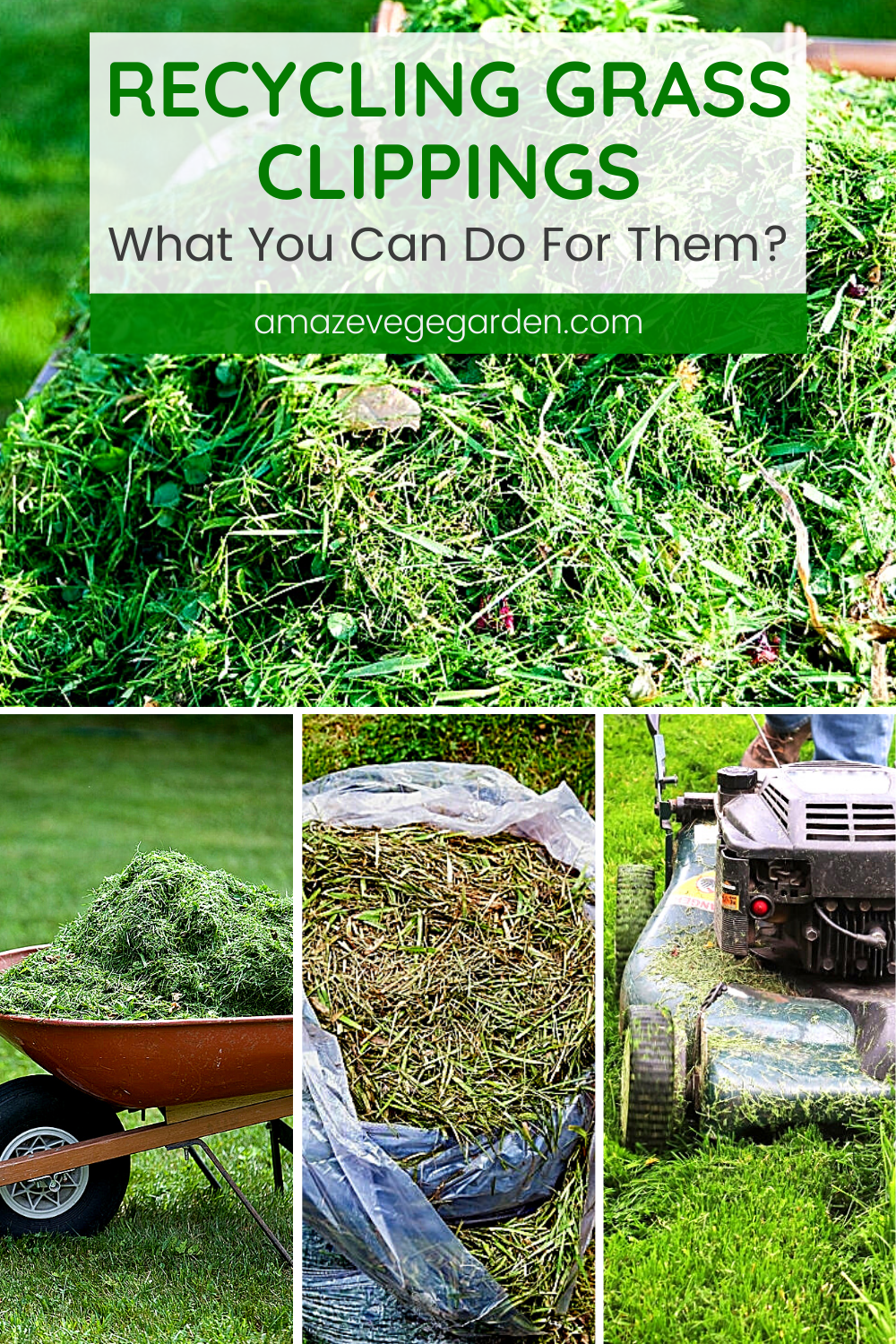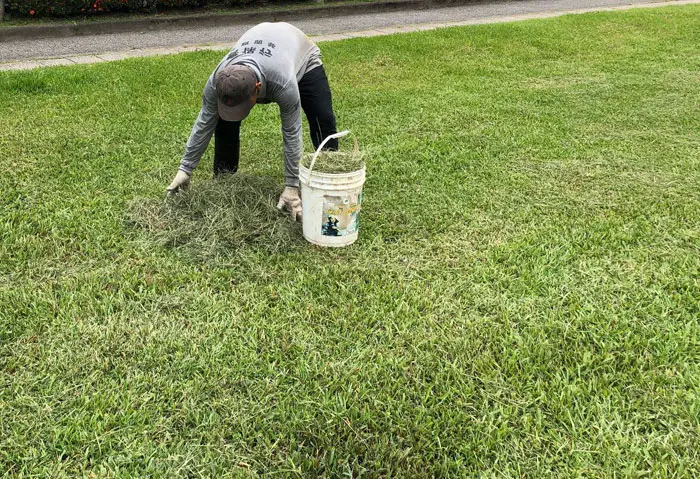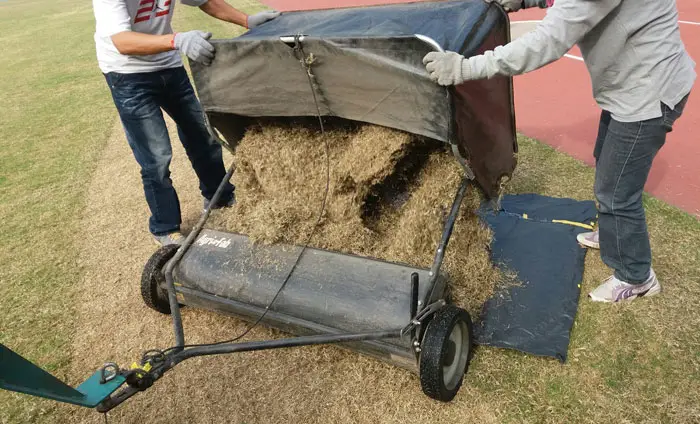When you mow your lawn, you will produce a lot of grass clippings. So how to deal with these grass residues? Traditionally, grass clippings have been bagged, thrown away, and sent to a landfill, where they make up 20% of the total refuse there.
What’s sad is that they are 100% recyclable and are much more beneficial to your lawn when they are left on the lawn. In fact, you can turn them into excellent organic fertilizer, which is more effective for growing flowers.
Here are the benefits that you can get from recycling grass clippings.
Stimulate Microorganisms and Earthworm Activity
Because grass clippings are 75% to 85% water, they break down quickly and don’t, as some people believe, contribute to a thatch problem. As the clippings break down, they stimulate microorganisms and earthworm activity.
Grass clipping recycling is an excellent strategy to lessen trash and improve soil quality. There are many beneficial species including earthworms that can benefit from the nutrients they provide to your plants. In addition to supplying food for important soil microbes like bacteria and fungi, these clippings also release nitrogen into the soil when they are chopped.
The organic matter from these clippings also increases the amount of water-holding capacity within the soil. This allows for better drainage and improved aeration, creating a perfect environment for healthy earthworm activity.
Earthworms are nature’s tillers. They work their way through the soil breaking it up so oxygen can reach deeper levels more easily. All of this microbial and worm activity adds vital minerals back into the topsoil, improving its fertility and structure over time. It’s easy to see why recycling grass clippings has such a positive impact on our gardens!
Replenish Nutrients To The Lawns
They also replenish the various nutrients that lawns need to maintain steady growth, especially nitrogen. Studies have shown that a lawn whose grass clippings are left to decompose needs 25% less of the annual fertilizer than other lawns need. This will save you both time and money.
Starting a grass-cycling program isn’t hard. It just takes good lawn maintenance practices. Grass clippings need to be small enough so that they can fall into the lawn easily, reach the soil, and break down at a reasonable rate. To keep your grass clippings small, you need to prevent grass overgrowth.
Be careful not to over-fertilize or overwater your lawn, and mow the grass frequently to keep it at its optimal height, without removing more than 1/3 of the leaf blade. Each type of grass seed has its own optimal height, listed below:
- Buffalograss: 2 ½”
- Bermudagrass: ½ to 2.”
- Kentucky bluegrass: 2”
- Perennial ryegrass: 1 ½ to 2”
- Tall fescue: 2 to 3”
- Zoysiagrass: ½ to 1.”
When your lawn is in its growing season, you will have to mow more frequently to keep the grass clippings small. If you cannot keep up with frequent mowing, or if several rainy days interrupt your normal schedule, there are a few things you can do with larger grass clippings.
Maintain a Balanced Soil Temperature
Recycling grass clippings is a great way to maintain a balanced soil temperature. By regularly introducing organic matter, you can keep the soil temperature from rising or dropping too quickly. Here are some of the benefits:
- Healthy root systems: The added organic material helps regulate temperatures and provides insulation for your plants’ roots in extreme weather conditions.
- Improved water retention: Organic mulch-like grass clippings also help retain moisture in the soil, reducing watering requirements during hot summer days.
- Increased nutrient availability: Nutrients are released into the soil as grass clippings decomposed, making them more available to plant roots.
It’s crucial to remember not to heap freshly cut grass clippings in your garden beds but rather to spread them out evenly over the surface. Too much concentrated organic matter will create pockets of anaerobic bacteria and attract pests like slugs and snails. Additionally, avoid using treated lawns with chemical fertilizers as these materials could potentially contaminate your composting system.
Retain Soil Moisture
Conserve the moisture in the soil and reduce the direct transpiration of moisture from the ground. The soil will be able to retain more of the water that is so desperately needed. In addition, you won’t have to spend a lot of money or time on laborious tasks to see significant results in your garden.
If you don’t have enough organic material for mulching, just spread out the grass clippings on top of the soil like a blanket. This helps reduce water loss and keeps your plants healthy. It also encourages beneficial earthworms and other organisms that help aerate and fertilize your soil naturally.
In addition, grass-clipping mulch can protect nearby trees and shrubs from extreme temperatures by insulating their roots. But be sure to leave some space around them so they get enough air circulation too. With these benefits, recycling your lawn cuttings is definitely worth considering if you want to conserve water while keeping your garden thriving!
Inhibit the Growth of Weeds
When the mulch itself does not contain grass seeds, and the thickness of the laying reaches more than 7 cm, it can effectively inhibit the germination of weed seeds and eliminate existing small weeds.
A thick blanket of green grass is the envy of any gardener, rolling down slopes and hugging curves. Yet this verdant vista can be quickly disrupted by an onslaught of pesky weeds. Recycling your grass clippings provides a simple solution to keeping these intruders at bay.
The clippings act as natural mulch when spread around plants or shrubs in the garden, shading weed seeds from sunlight and creating an inhospitable environment for them to germinate. This not only eliminates the need for harsh chemical herbicides but also helps retain soil moisture and prevents erosion due to wind or heavy rain.
Plus, with regular mowing, you’ll already have plenty of material on hand! Grass clippings are easy to use — simply spread them out over existing beds where weeds may sprout or create new planting areas that will remain free from unwanted visitors. With minimal effort, you can keep your lawn looking lush without having to worry about tackling troublesome weeds again.
With nature’s own method for preventing weed growth, we can take one more step towards a healthier garden – and the planet!
Prevent Soil Compaction
You can use recycled grass clippings to prevent the compaction of the soil surface. They can also help improve the absorption and penetration of water in the soil and reduce water and soil loss.
Here are some ways you can use them:
- Protect the roots of trees and shrubs from dry soil and high temperatures by spreading a thin layer of clippings around them.
- Mulch weeds and conserve moisture by spreading clippings thickly around flower beds and vegetable gardens.
- To prevent erosion from rain or wind, spread a two-inch layer of clippings along walkways or roadways.
- Employ nitrogen-rich grass clippings as an organic fertilizer to feed your plants’ roots without harming their tender stems and foliage.
Not only do recycled grass clippings help with preventing soil compaction, but they also improve its structure as well! The material acts like tiny sponges which absorb water when it rains, allowing oxygen to enter into the soil so plant roots have access to essential nutrients needed for growth and development.
By adding organic matter such as grass clippings helps increase beneficial microorganisms present in the dirt, leading to the better overall health of the ecosystem in your backyard oasis! To make sure your efforts are successful though, be sure not to add more than 3 inches at any given time to avoid smothering your plants beneath an overly saturated mound of composted waste material. With these tips in mind, recycling grass clippings can help maintain healthy soils year after year!
Improve Soil Structure
Organic materials such as mulch can improve soil structure and farming performance. After the organic mulch decays and decomposes, it can also be used as a fertilizer to supplement the soil’s nutrients.
Recycling your grass clippings is a simple yet effective way to give back to the soil. When reintroduced into your lawn, these organic materials help boost its health and vitality. And with just one easy step – mowing and mulching – you can go from having an average-looking lawn to a lush green paradise!
Nothing screams “healthy” like living soils full of microorganisms that are teeming with activity. Grass clippings contain nitrogen, potassium, phosphorus, and other minerals that feed the bacteria in the soil, which helps break down nutrients for maximum absorption by plants. In addition, returning grass clippings to the lawn provides valuable organic matter to improve air circulation, water retention, and biological activity within the soil.
Not only does recycling grass clippings provide important nutrients for plants and beneficial microbes in the soil; but it also improves overall soil structure as well. The finely chopped material acts as tiny sponges when mixed into the top layer of soil providing aeration channels for roots and better drainage so water doesn’t puddle on top or run off too quickly. It also adds interesting textures to the lawn surface while helping reduce compaction caused by foot traffic or heavy equipment.
Provide Interest Textures To the Lawn Surface
You can recycle grass clippings by covering them on the lawn. This can provide balanced colors and interesting textures to the surface of the lawn. It’s a simple and inexpensive fix that can completely transform the aesthetic of your yard. Grass clippings that have been recycled into the lawn serve as a natural fertilizer and also provide visual interest. Hence, you can have healthy, green grass without spending as much on fertilizers and other soil treatments.
Grass clippings can be reused because they include organic matter that breaks up compacted soil and increases water and nutrient penetration to plant roots. Another benefit of the grass’s thin blades is that they trap pockets of air, whether warm or cold, around the roots, protecting them from the effects of temperature extremes. Including additional organic matter into your soil will also increase its drainage capacity, preventing standing water after prolonged rains or waterings.
Recycled grass clippings can help you to maintain your lawn healthily and beautifully. This simple but efficient solution enhances the aesthetics and sustainability of any outdoor environment. Using “waste” during the mowing season has several benefits, both environmentally and aesthetically.
Promote The Growth of Roots
Plants can promote the growth of roots under the coating of organic mulch. Comparing these roots grown in the mulch environment with the roots grown in ordinary soil, it turns out that the roots in the mulch are better than those in ordinary soil. The condition of hair roots is much better.
By adding the clippings to your soil, you are giving plants a nutrient-rich source of food! This helps them grow stronger, faster, and healthier. The nutrients found in grass clippings, like nitrogen and phosphorous, act as natural fertilizers for any garden or lawn. Additionally, recycling these clippings can help conserve water; when added to the soil they help retain moisture so that you don’t need to water as often.
Not only do grass clippings provide essential nutrients and help save on water usage but they also improve soil structure. When recycled correctly they form a layer of protection over the topsoil which prevents it from drying out too quickly, reduces erosion from wind or rain, and keeps weeds at bay. Plus, the organic matter in grass clippings breaks down easily meaning it won’t suffocate delicate plant roots like other mulches may do.
Turn Them Into Compost
The most commonly used of these grass clippings is to turn them into compost, which you can make into decomposed organic fertilizer.
You can directly mix these grass clippings with other compost materials, such as fallen leaves, dead branches, coffee residues, tea residues, eggshells, peels, etc.
You can add some garden soil. Then you can mix them in a compost pile or put them in the compost bin.
In the later stage, make sure to keep the compost pile loose, breathable, and with proper moisture. You need to stir them regularly and avoid stagnant water stay on your compost pile. It will become a decomposed fertilizer in about 3 to 6 months.
Making Organic Liquid Fertilizer
you can also turn these grass clippings into a good organic liquid fertilizer. So, it would be best if you kept all the grass clippings after mowing your lawn instead of disposing of them.
You can mix them into the water to become organic liquid fertilizer that will contain more nutrients such as nitrogen, potassium, phosphorus, and amino acids.
You can soak the grass clippings in clean water for about three days to filter out the residue. These solutions can be mixed with water and sprayed on the leaves of the plants to supplement nutrients to the plants.
When spraying, be sure to add water because the concentration of these organic fertilizers will be very high which can easily burn the plants. Generally, The ratio of liquid fertilizer with water is about 1 to 50 or 100 times, depending on the strength of the plants.
Use Them As Mulch
These scraps of grass clippings can become a perfect mulch, which you can spread on the soil’s surface to help retain water, inhibit weeds, keep the soil cool, and improve the fertility of the soil.
One option is to use a mulching mower. Mulching mowers will cut clippings into even smaller clippings so that they can decompose easily. Another option is to remove the larger clippings from the lawn and compost them. You can also use them as mulch for gardens or surrounding trees.
Whether they are fresh grass or dry grass clippings, you can turn them into very high-quality organic mulch. These grass clippings contain a large amount of nitrogen, which is very helpful to the growth of plants.
It would help if you took note that you should not spread these grass clippings directly at the bottom or on the roots of the plants. The ideal distance should be 3cm to 5 cm away from the plant rhizomes.
Usually, whether you are planting vegetables, foliage plants, or flowering plants, you can use these grass clippings and spread them on the soil 3 cm thick.
Even if there is no plant in your lawn, you can still spread a layer of 5 cm thick grass clippings on the soil. By doing so, it can help to improve the structure of the soil and make the soil to be more fertile.
Right now, we should know that mulch is extremely beneficial to your lawn. It helps reduce weeds, regulates soil temperature, retains moisture, and limits soil erosion. Ensure that you do not use grass clippings that have come into contact with herbicides within the past two weeks. Let those break down on the lawn, or bag them if necessary.
So, it would be best if you recycled your grass clippings and made them to good use. Don’t simply dispose of them. You can also leave the grass clippings on your lawn since this is a natural and efficient way to keep your lawn green, healthy, and growing.
Did you find this post useful? Would you like to get back to it later? Save THIS PIN below to your lawn care and gardening boards on Pinterest! Thanks 🙂



